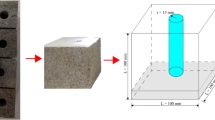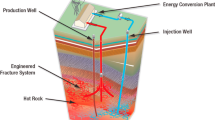Abstract
Under thermal shock, the heat conduction between granite and fluid will lead to the redistribution of rock temperature field, while indoor thermal shock test cannot determine the distribution rule of temperature field inside granite accurately. In order to explore the influence of fluid velocity on the thermal shock process of granite, the temperature field and flow field is numerically simulated by COMSOL. The results show that heat transfer between granite and fluid is in the form of waves. In the process of heat conduction, the internal temperature and heat balance time of granite are greater than those of rock surface. The time of heat balance in rock provides reference for the design of indoor thermal shock test. After thermal shock, the temperature of granite is lower than the initial temperature. With the increase of fluid velocity, the thermal equilibrium time of granite decreases, and the final rock stable temperature decreases. According to the relationship between velocity and granite temperature, a linear correlation model between velocity and maximum instantaneous thermal shock velocity is proposed. It is also verified that the thermal fluid–solid coupling model of granite under thermal shock is feasible to simulate the heat conduction and temperature distribution in granite.








Similar content being viewed by others
References
Chen SW, Yang CH, Wang GB (2017) Evolution of thermal damage and permeability of Beishan granite. Appl Therm Eng 110(1533–1):542
Chen BK, Ranjith PG, Perera MSA (2018) Experimental investigation of quenching effect on mechanical, microstructural and flow characteristics of reservoir rocks: thermal stimulation method for geothermal energy extraction. J Petrol Sci Eng 162:419–433
Foraboschi P (2017) Analytical modeling to predict thermal shock failure and maximum temperature gradients of a glass panel. Mater Des 134:301–319
Guo Q, Pan J, Cai M, Zhang Y (2020a) Investigating the effect of rock bridge on the stability of locked section slopes by the direct shear test and acoustic emission technique. Sensors 20(3):638
Guo Q, Dong Z, Cai M, Ren F, Pan J (2020b) Safety evaluation of underground caverns based on Monte Carlo method. Math Probl Eng 2020:1–7
Jin PH, Hu YP, Shao JX, Zhao GK, Zhou XZ, Li C (2018) Experimental study on physico-mechanical and transport properties of granite subjected to rapid cooling. Chin J Rock Mech Eng 37(11):2556–2564
Lin MZ (1991) Thermal physics of rock and its application. Chongqing University Press, Chongqing, pp 142–145
Liu H, Yang GS, Tian JF, Xu J (2007) Microstructural character and numerical simulation of temperature field of frozen-rock. Chin J Undergr Space Eng 6:1127–1132
Qian DD, Liu PY, Zhang Y, Ma L, Wang J, Xing X (2018) Impact of thermal shock cycles on mechanical properties and microstructure of lithium disilicate dental glass-ceramic. Ceram Int 44(2):1589–1593
Shao JX (2018) Experimental study on damage and fracture evolution of sandstone under thermal stress. Taiyuan University of Technology, Taiyuan
Shao SS, Wasantha PLP, Ranjith PG (2014) Effect of cooling rate on the mechanical behavior of heated Strathbogie granite with different grain sizes. Int J Rock Mech Mining Sci 70:381–387
Tang YS (2016) Study on the thermal solid coupling experimental characteristics of granite. Hubei University of Technology, Hongshan
Wan ZJ, Zhao YS, Dong FK, Feng ZJ, Zhang N, Wu JW (2008) Experimental study of mechanical characteristics of granite under high temperatures and triaxial stresses. Chin J Rock Mech Eng 27(1):72–77
Wang RF (2002) 3D solid-flow-heat coupled numerical simulation in exploitation of HDR. Taiyuan University of Technology, Taiyuan
Wang P (2014) Impact of chemical-temperature-stress coupling on mechanical properties of rock. Shanghai University of Technology, Shanghai
Xi BP, Zhao YS (2010) Experimental research on mechanical properties of water-cooled granite under high temperatures within 600 °C. Chin J Rock Mech Eng 29(5):892–898
Xi BP, Wu YC, Zhao YS (2019) Experimental study on the relationship between macroscopic mechanical parameters of granite and thermal shock velocity under thermal shock. Chin J Rock Mech Eng 38(11):2194–2207
Xiong GM, Xi BP, Wu YC, Chen LH (2018) Numerical study on distribution of temperature field of dry hot rock under under hot shock. J Taiyuan Univ Technol 49(6):820–826
Xu SL, Xi DY, Tang ZP, Li T, Du Y, Xi J (2007) A preliminary investigation of rock subjected to thermal shock. Chin J Rock Mech Eng 26(1):3468–3472
Xu XL, Gao F, Gao YN, Xie HP (2008) Effect of high temperatures on the mechanical characteristics and crystal structure of granite. J China Univ Min Technol 37(3):402–406
Zhang ZJ, Hu P, Chen LM et al (2018) Effect of surface heat transfer coefficient gradient on thermal shock failure of ceramic materials under rapid cooling condition. Ceram Int 44(8):8992–8999
Zhao YS, Wan ZJ, Kang JR (2004) An introduction to hot dry rock (HDR) geothermal exploitation. Science Press, Beijing, pp 68–106
Zhao YS, Wan ZJ, Feng ZJ (2017) Evolution of mechanical properties of granite at high temperature and high pressure. Geomech Geophys Geo-energy Geo-resour 3(2):199–210
Zhu ZN, Tian H, Dong NN, Dou B, Chen J, Zhang Yu, Wang BH (2018) Experimental study of physic mechanical properties of heat-treated granite by water cooling. Rock Soil Mech 9(Supp. 2):169–176
Zuo JP, Zhou HW, Fang Y (2011) Experimental research on thermal cracking of deep granite in Beishan region, Gansu province. Chin J Rock Mechan Eng 30(6):1107–1115
Acknowledgements
This work was supported by Fundamental Research Funds for the Central Universities (No. FRF-TP-18-015A3) and National Key R&D Program of China (No. 2018YFE0101100).
Author information
Authors and Affiliations
Corresponding authors
Ethics declarations
Conflict of interest
The authors declare that they have no known competing financial interests or personal relationships that could have appeared to influence the work reported in this paper.
Additional information
Publisher's Note
Springer Nature remains neutral with regard to jurisdictional claims in published maps and institutional affiliations.
Rights and permissions
About this article
Cite this article
Wu, X., Wang, P., Guo, Q. et al. Numerical Simulation of the Influence of Flow Velocity on Granite Temperature Field Under Thermal Shock. Geotech Geol Eng 39, 37–48 (2021). https://doi.org/10.1007/s10706-020-01305-6
Received:
Accepted:
Published:
Issue Date:
DOI: https://doi.org/10.1007/s10706-020-01305-6




